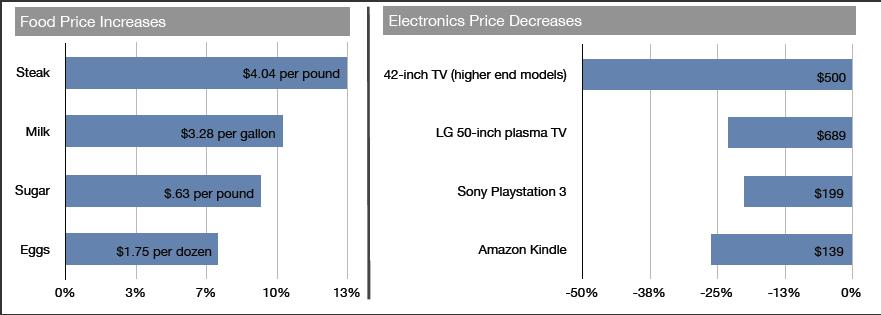Where Black Friday and holiday prices prices are trending
By Oregon Small Business Association,
This Black Friday and Holiday season prices have already witnessed huge drops in electronic goods and toys (as the Black Friday chart below shows). At the same time Americans will pay at the holiday dinner table with higher food prices.
Black Friday decreases in electronic prices and toys
Electronic manufacturers, especially flat screen TVs, are seeing slashing prices much more aggressively than holiday seasons past.
As inventory starts to build up from a slower than normal fall season, prices for flat screen TVs, Sony Playstation 3 and the popular, Kindle e-book have already seen price drops from 20% to 50%. With the holiday shopping season upon us, we will continue to see price drop and bundling of options. Retailers, such as Best Buy are combining flat screen TVs with other extras, such as the 50-inch Samsung plasma 3D television, two pairs of glasses, $50 in movies and a video game for $1000. Some are offering free delivery for added value. The Wall Street Journal reports of a new price war erupting over toys between Wal-Mart, Amazon, Target and Toys R’ Us in a report entitled “Wal-MArt Fires Shot in Toy War.” Amazon and Toys R’ Us have already broadcasted 25% price cuts. Wal_Mart which has in the past shrunk its toy inventory by as much as 30% is expanding this year by promoting $10 and $5 items.
Increase in Food Prices
A new survey shows that products sold at Walmart are on a rise of 0.6% in just two months. Food prices are being driven by a growing demand for meat in China and India, which drives up prices for grains, and also leads to higher prices for chicken, steak, bread and pasta. Food prices are rising faster than overall inflation, with the food index rising 1.4%. The U.S. Agricultural Department expects overall food inflation of 2% to 3% next year. Retailers, with pressure to pass the extra costs to the customer are hesitant because of lessons learned from October 2008 when shoppers switched to generic labels when food prices saw a 6.3% increase.
Disclaimer: Articles featured on Oregon Report are the creation, responsibility and opinion of the authoring individual or organization which is featured at the top of every article.



